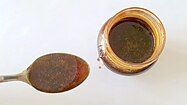User:Gobonobo

Hi! I'm gobonobo. I've been a Wikipedia editor since before hashtags. I survived 100 wikidays, have written around 1000 articles, and have made over 100,000 edits to the English Wikipedia and Wikidata. I patrol recent changes, review draft articles, revert vandalism, and monitor social media for errors that have slipped through the cracks. I sometimes contribute to the did you know... section on the main page and have uploaded oodles of images both here and on Commons.
As an editor, I focus on a wide variety of content and try to address systemic bias, especially in regards to gender, racial and geographic biases. I am a member of several WikiProjects, support GLAM initiatives, and have volunteered with Art+Feminism and participated in Black Lunch Table events. I've organized edit-a-thons and led editing workshops at the Loft, Mia, the American Craft Council, St. Kate's, Hamline, and the U of M.
About me
[edit]
|
I hail from Minnesota where I learned how to be nice and ride tall bikes. While my username refers to the most enlightened of the great apes, I am actually a night owl who enjoys rabbit holes. I use Linux and support the free and open-source software movement. I have a background in the cooperative movement and consensus decision-making. I'm a C-SPAN junkie and enjoy listening to Wikipedia, time-travel romance, and long bicycle rides where I can snap photos for Wikishootme.
I made my first edit to Wikipedia in 2006 and my early focus centered on different types of cooperatives. Early on I was an online ambassador, working with university classes (before Wiki Ed) and worked briefly with the volunteer response team. I later became involved in efforts to address the gender gap. I no longer maintain my gender gap red list, as the Women in Red lists are far more comprehensive. I was privileged to be a part of the group that organized an edit-a-thon at the Minneapolis Central Library where the Guerrilla Girls were guests of honor and to be among the Wikimedians who convinced the Minnesota Historical Society to license their MNopedia content as CC BY-SA. I supported the global blackout of this site in opposition to SOPA, have been described as a "Wikipedia Angel" and was the first editor to note the death of Kim Jong Il.
| Barnstars | |||||
|---|---|---|---|---|---|
Did you know... contributions
|
|---|
 Blotter art of the Eye of Horus
|
| “ | It is like some vast aerial city with people walking briskly to and fro on catwalks, carrying picnic baskets full of nutritious snacks.[1] | ” |
uʍopǝpᴉsdn ʇnq 'ʎɐp ǝɥʇ ɟo ǝɹnʇɔᴉd s,ʍoɹɹoɯoʇ
European bison
- Members of the Fifteen Year Society of Wikipedia editors
- WikiProject Women in Red participants
- WikiProject Cooperatives participants
- WikiProject Argentina participants
- WikiProject Minnesota participants
- WikiProject Women's History participants
- WikiProject Women scientists participants
- WikiProject Women artists participants
- WikiProject Women writers participants
- Gender gap task force participants
- WikiProject Feminism participants
- Wikipedia Did you know contributors

















